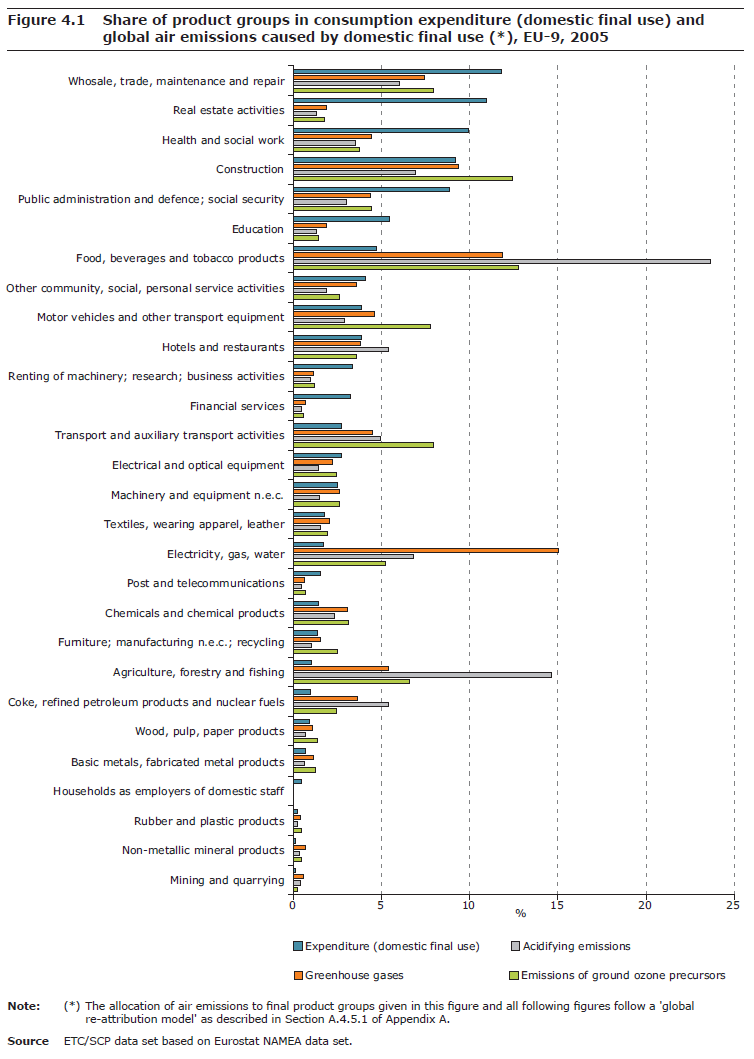The European Environment Agency has released a report studying “Environmental pressures from European consumption and production”. At 124 pages of “environmentally extended input-output analysis”, it isn’t exactly casual reading for your next beach holiday. They have, however, some quite interesting stuff in there. On the production side, the report mentions the EU climate objective of 80-95% reduction in greenhouse gas emissions by 2050.
We Must Change What We Consume
They make the interesting point that regardless of the structural changes we make to the production side of our economy they will only have global environmental benefits if we have an equivalent change in the products we consume. The reason is simple. If we don’t change our consumption, then environmental pressure-intensive industries will shift outside the EU but we will still import their products. We’ll do as much damage and possibly more (if we consider the possibility that production may shift to regions with less stringent environmental standards). So the consumption side of our economy is important. That makes each of us, as consumers, important which is why it interests us here at Green Business Watch.
Four product groups were found to be major sources of environmental pressures. These are:
- Construction works
- Food products
- Products of agriculture, forestry and fisheries
- Electricity, gas and water services
Together these 4 represent only 17% of consumption expenditure but they contribute 42% of GHG emissions, 52% of acidifying emissions, 37% of ground ozone precursors and 57% of material input. I’m not even going to pretend to know what all of those figures mean except to say that these product groups have much higher numbers on the environmental impact side than they do as a percentage of our consumption spending. They are environmental pressure-intensive. To put it another way, for every Pound we spend, these are the areas that do the most environmental damage.
The report highlights another 7 product groups
- wholesale and retail services
- motor vehicles and other transport equipment
- hotel and restaurant services
- transport and auxiliary transport services
- coke and refined petroleum
- health and social work
- public administration, defence and social security services
Together these account for a further 30-40% of environmental pressures from consumed products. They also account for a 42% share of consumption expenditure however so they are less pressure-intensive.
Our households directly contribute around 20% of environmental pressures and this is mainly in the fuel consumed in our vehicles and to heat our houses. On top of this, however, most final products end up in households and private household consumption represents 55% of total national consumption.
How does our household consumption break down and how does it affect emissions?

To help us understand the importance of our consumption and the decisions we make for our households, here is the section on Greenhouse Gas Emissions:
“The average per capita GHG emissions associated with consumption in the 9 EU Member States in 2005 were just under 12 tonnes CO2‑ equivalents — 4 to 5 times the estimated global per capita average which would keep global temperature rise to within the critical 2 °C target set by the Copenhagen Accord.
“Of this total, nearly 2.5 tonnes are emitted directly by private households through the combustion of fossil fuels for transport (around 43 %), and directly in the home for space heating and hot water and other purposes (around 57 %) (41). The remaining 9.4 tonnes are embodied in finally consumed products according to the proportions given in the second bar down in Figures 4.1 and 4.2. The most important product with respect to GHG emissions is electricity, followed by food and beverages and construction works.”
There is lots of interesting stuff in the report if you are up to 124 pages of research but here are a few things we took from it.
Regardless of structural changes in the economy and production, we will need to change what we consume (and how it is produced) if emissions are to be reduced. A large chunk (2.5 tonnes) of the CO2 our households generate is in fuel for transport and fuel for space heating. Even more (9.4 tonnes) is embodied in the products and services that we consume. Top of the list for reducing the carbon impact of our consumer decisions are these:
- Electricity
- Food and beverages
- Construction works
So now that we know where the damage is being done, let’s get to work on changing what we buy.


